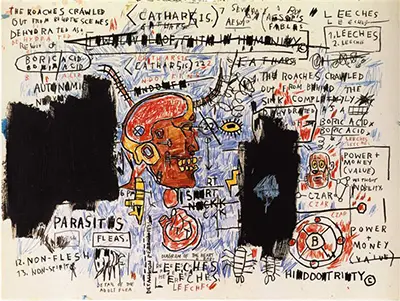The artist would use repetition throughout many of his paintings and we find it here again with the title of the artwork placed many times over in an almost ranting manner. There seems to be an expression of anger and frustration by the artist in this piece, as he clearly targets a group of people who we will need to study the piece in order to identify them. He would regularly speak out against the police, for example, as well as elements of the caucasian community and so this expressive criticism is entirely common within his career. Other parasites are then listed in the bottom left corner in the scrawled typography which the artist was just so fond of. He would capitilise his letters and mix up the angles in which his words were delivered, giving something of a childlike quality but his efforts were entirely planned and cultivated, hence the relative consistency of this chaotic approach from one painting to another.
The consistency allows those knowledgeable on his career to better understand the meanings behind his paintings, whilst those unfamiliar will simply see a random generation of objects without any message, akin to the scribblings of a madman. That is why experts in this field are just so important in helping us to better understand the mind of the artist and also to place paintings such as Leeches within the greater context of his overall career. Basquiat was a wonderful fusion of different cultures and artistic styles which influenced both the style of his work, but also the content. It was specific elements of life in New York which drove many of the paintings from his period in the ealry 1980s, at a time when social change was turbulent.
Basquiat was consistent in his output and rarely went away from this graffiti like approach. Some of his most famous paintings included the likes of Irony of Negro Policeman, Trumpet and Skull. He also developed a set of icons which would be re-used, alongside consistent meanings, across a number of his artworks and these help historians to pinpoint other works from his career, some of which became dispersed geographically over time. Today he is regarded as one of the most famous American artists in history and a true talent who spoke for a number of communities who had normally struggled to find a place in the mainstream art world, particularly so back in the time of this artist.


